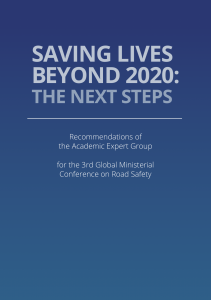
Embracing a new decade of improved road safety goals
This page was last reviewed on May 11, 2020
By Pamela Fuselli, President and CEO, Parachute.
“Road safety is a necessity for health, climate, equity and prosperity. If children cannot walk or bicycle to school without risking their lives, we limit their access to education, good health and freedom, and consequently our hope for the future. If we cannot transport goods across a nation or around the world in a safe and sustainable way, we limit the possibility of trade, economic development and elimination of poverty. If our workplaces are not safe, we threaten earnings and the sustainability of families. Elimination of deaths and serious injuries in road traffic is essential to many other sustainability goals in very direct and clear ways. Road traffic safety can no longer develop in isolation.”
– Saving Lives Beyond 2020: The Next Steps.
How do we get to zero deaths on our roadways, the ultimate goal for the Vision Zero Road Safety movement?
I was one of 1,700 delegates from 140 countries, including government ministers, at the 3rdGlobal Ministerial Conference on Road Safety in Stockholm and we took a big step in that direction earlier this year: current projections predict up to 500 million road traffic deaths and injuries over the next decade, and the goal was set to reduce that by at least half.
We’ll get there by following nine recommendations adopted at this international conference, contained in the report, Saving Lives Beyond 2020: The Next Steps. The report was developed in the context of the 2030 Agenda, often referred to as the Sustainable Development Goals (SDGs). When these 17 goals were issued by the United Nations in 2015, road safety was explicitly included for the first time as part of the global development agenda. As the Saving Lives Beyond 2020 report puts it, “this heightened recognition gives us a new and unique opportunity to accelerate progress.”
This recognition of road safety elevates the issue in terms of a global priority and also communicates the importance of stakeholders from both the private and public sectors working together. As never before, we are recognizing the global nature of life, the integral connections among issues, the importance of prevention strategies in addressing public health issues and the need for collective, co-ordinated action.
The nine recommendations adopted are:
- Sustainable Practices and Reporting: including road safety interventions across sectors as part of Sustainable Development Goal contributions.
- Procurement: using the buying power of public and private organizations across their value chains.
- Modal Shift: moving from personal motor vehicles toward safer and more active forms of mobility.
- Child and Youth Health: encouraging active mobility by building safer roads and walkways.
- Infrastructure: realizing the value of Safe System design as quickly as possible.
- Safe Vehicles Across the Globe: adopting a minimum set of safety standards for motor vehicles.
- Zero Speeding: protecting road users from crash forces beyond the limits of human injury tolerance.
- 30 km/h: mandating a 30 km/h speed limit in urban areas to prevent serious injuries and deaths to vulnerable road users when human errors occur.
- Technology: bringing the benefits of safer vehicles and infrastructure to low- and middle-income countries.
The previous Global Plan for the 2011–2020 Decade of Action of Safety included a set of evidence-based interventions that can measurably improve the safety of road traffic, especially if they are applied with a Safe System approach, another term for Vision Zero, which recognizes that road transport is a complex system and that humans, vehicles and the road infrastructure must interact in a way that ensures a high level of safety.
A World Health Organization resolution in 2016 resulted in the collaboration with United Nation Membersand agreement on 12 global road safety targets for the prevention and control of road traffic injuries.
Looking at these 12 global road safety targets (read them via the link above if you’re not familiar with them) and the nine recommendations from this year’s Stockholm conference, Canada has made or is currently working on activities that take steps toward achieving these goals. Some examples include:
- The publication of the Road Safety Strategy 2025 that outlines how jurisdictions and partners are and can work together
- Vision Zero gaining momentum in provinces and municipalities across the country
- Strengthened laws that restrict mobile phone use
- A compliance rate of 95 per cent for seat belt use
- Moves to implement solutions such as rumble strips and lowering urban speed limits to 30 km/h.
That said, we cannot rest on our laurels.
Since our February conference, the world has changed. Dramatically. In cities around the world, we’ve seen empty streets, reduced air pollution, streets being cleared for walking and biking, reduced congestion and commuting as people work from home and appreciation of strong and responsive health systems and emergency care. Prevention is also moving to the forefront of people’s way of dealing with everyday challenges. The effectiveness and importance of prevention is in society’s consciousness now. These are changes we in the road safety community and other groups – safe transport, environment, climate change and physical activity sectors – have advocated for, for a long time.
The momentum at the 3rdGlobal Ministerial Conference on Road Safety to collaborate and accelerate collective action is even more relevant. How do we keep the positive things that have come from this unprecedented global situation, how do we frame our arguments around it respectfully, and which groups are there to partner with to collectively address these issues once the crisis has passed and how do we do that?
There is a tangible opportunity that the road safety community, along with those working for environmental and physical activity improvements, need to purposefully plan for that will make our roads safer, and our planet better, for everyone.
Pamela Fuselli attended the 3rd Global Ministerial Conference on Road Safety through the support of our Vision Zero partner, Desjardins.